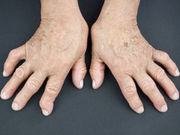HZ risk comparable after initiation of TNFi, non-TNFi, and conventional synthetic DMARDs
FRIDAY, Dec. 11, 2015 (HealthDay News) — Patients with rheumatoid arthritis (RA) have increased herpes zoster (HZ) risk with older age and higher prednisone dose, according to a study published in the December issue of Arthritis Care & Research.
Dimitrios A. Pappas, M.D., M.P.H., from the Columbia University College of Physicians and Surgeons in New York City, and colleagues examined the RA characteristics associated with increased HZ risk among RA patients in the Corrona registry. For RA patients taking current or past methotrexate, the medication-related risk for HZ was categorized by treatment initiation (tumor necrosis factor inhibitors [TNFi], non-TNFi biologic agents, and conventional synthetic disease-modifying antirheumatic drugs [csDMARDs]).
A total of 28,852 patients contributed data for 95,287 person-years. The researchers found that there were 729 HZ cases, for a crude incidence rate of 7.7 per 1,000 patient-years. Increased HZ risk was seen with increasing age (hazard ratio, 1.14 per five years) and prednisone therapy ≥7.5 mg/day (hazard ratio, 1.81). Propensity score-stratified analysis showed that the hazard ratio was 1.36 for csDMARDS (95 percent confidence interval, 0.82 to 2.25) and 0.83 for non-TNFi (95 percent confidence interval, 0.51 to 1.38), compared with TNFi exposures.
“In the Corrona registry, the HZ risk in RA patients taking prior or current methotrexate increased with older age and higher prednisone dose,” the authors write.
Several authors disclosed financial ties to the pharmaceutical industry; the study was funded by Corrona. The Corrona RA registry was supported by donations from pharmaceutical companies.
Copyright © 2015 HealthDay. All rights reserved.








